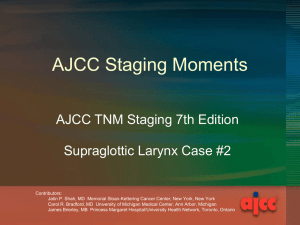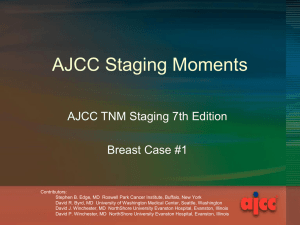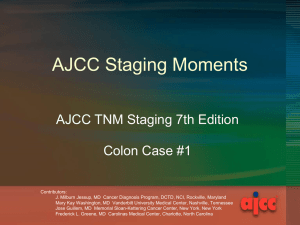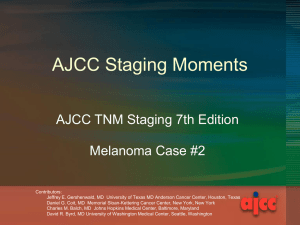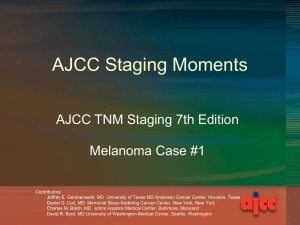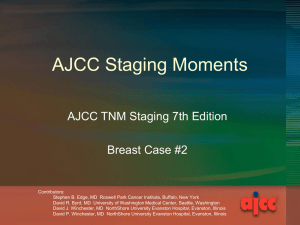Staging Moments Head and Neck Case 1
advertisement
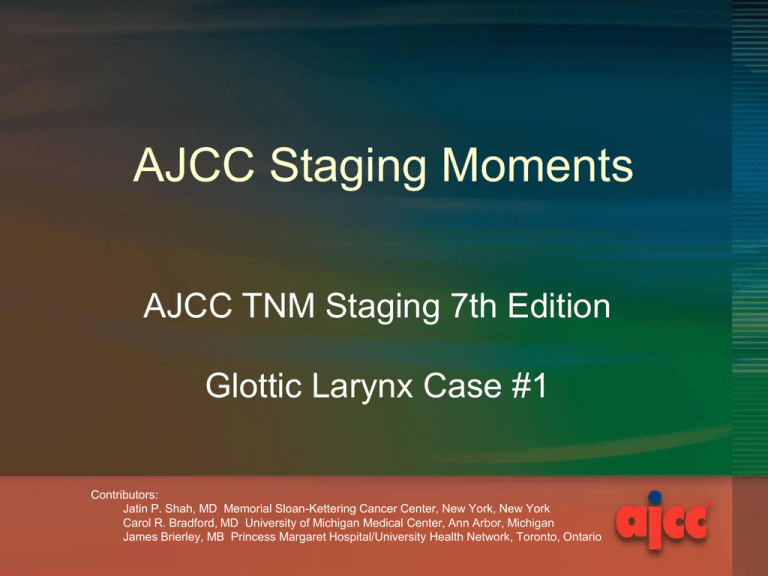
AJCC Staging Moments AJCC TNM Staging 7th Edition Glottic Larynx Case #1 Contributors: Jatin P. Shah, MD Memorial Sloan-Kettering Cancer Center, New York, New York Carol R. Bradford, MD University of Michigan Medical Center, Ann Arbor, Michigan James Brierley, MB Princess Margaret Hospital/University Health Network, Toronto, Ontario Larynx Case # 1 Presentation of New Case • Newly diagnosed larynx cancer patient • Presentation at Cancer Conference for treatment recommendations and clinical staging Larynx Case # 1 History & Physical • 63 yr old female who presented with a raspy voice, no palpable lymphadenopathy • No smoking hx • No family history of ca Larynx Case # 1 Imaging & Endoscopy Results • CT neck – Left vocal cord lesion – No regional nodes involved • CT chest – Negative • Laryngoscopy & biopsy – 1cm lesion involving left vocal cord and possibly extending to anterior commissure – Normal cord mobility Used with permission. Shaker R, Loehrl T. Gastroenterology and Hepatology: Esophageal Diseases. Edited by Mark Feldman (series editor), Roy C. Orlando. ©2002 Current Medicine, Inc. Larynx Case # 1 Diagnostic Procedure • Procedure – Biopsy left vocal cord during laryngoscopy with operating microscope • Pathology Report – Well differentiated squamous cell ca – Grade 1 • HPV status is negative Larynx Case # 1 Clinical Staging • Clinical staging – Uses information from the physical exam, imaging, and diagnostic biopsy • Purpose – Select appropriate treatment – Estimate prognosis Larynx Case # 1 Clinical Staging • Synopsis- patient with small lesion on left vocal cord, clinically negative lymph nodes • What is the clinical stage? – – – – T____ N____ M____ Stage Group______ Larynx Case # 1 Clinical Staging • Clinical Stage correct answer – – – – T1a N0 M0 Stage Group I • Based on stage and other factors, treatment is selected • Review NCCN treatment guidelines for this stage Larynx Case # 1 Clinical Staging • Rationale for staging choices – T1a for tumor limited to one vocal cord (may involve anterior or posterior commissure) with normal mobility – N0 because nodes were clinically negative on physical exam and imaging – M0 because there was nothing to suggest distant metastases; if there was, appropriate tests would be performed before developing a treatment plan Prognostic Factors Clinically Significant • Applicable to this case – Human papillomavirus (HPV) status: neg HPV is less prevalent in laryngeal cancer than oropharyngeal cancers • There are no prognostic factors required for staging Larynx Case # 1 Presentation after Surgery • The choice of treatment lies between – Definitive external beam radiotherapy – Endoscopic laser resection – Open partial laryngectomy • The procedure chosen based on patient factors and the lesion confined to one vocal cord and clinically negative nodes, Stage I, is partial laryngectomy • Presentation at Cancer Conference for adjuvant treatment recommendations and pathologic staging Larynx Case # 1 Surgery & Findings • Procedure – Partial laryngectomy • Operative findings – No additional information Larynx Case # 1 Pathology Results • • • • • • • • Squamous cell carcinoma, involving lt vocal cord Tumor size - 1.2cm Grade - moderately differentiated Maximal thickness - 0.7cm Invades lamina propria Extension to anterior commissure Margins negative 4 regional nodes negative Larynx Case # 1 Pathologic Staging • Pathologic staging – Uses information from the clinical staging supplemented or modified by information from surgery and the pathology report • Purpose – Additional precise data for estimating prognosis – Calculating end results (survival data) Larynx Case # 1 Pathologic Staging • Synopsis- patient with 1.2cm lt vocal cord lesion extending to the anterior commissure, regional nodes negative • What is the pathologic stage? (remember, clinical M may be used in pathologic staging) – – – – T____ N____ M____ Stage Group______ Larynx Case # 1 Pathologic Staging • Pathologic Stage correct answer – – – – pT1a pN0 cM0 Stage Group I • Based on pathologic stage, there is more information to estimate prognosis and for selection of adjuvant treatment. Larynx Case # 1 Pathologic Staging • Rationale for staging choices – pT1a for tumor limited to one vocal cord (may involve anterior or posterior commissure) with normal mobility – pN0 because regional nodes were negative – cM0 - use clinical M with pathologic staging unless there is pathologic confirmation of distant metastases Prognostic Factors Clinically Significant • Applicable to this case – Size of lymph nodes: n/a – Extracapsular extension from lymph nodes: n/a – Lymph node levels involved: n/a – Extracapsular spread (ECS) pathologic: n/a – Human papillomavirus (HPV) status: neg • There are no prognostic factors required for staging AJCC Cancer Staging Atlas T1 limited to vocal cord(s), normal mobility T1a one vocal cord T1b both vocal cords Larynx Case # 1 Recap of Staging • Summary of correct answers – Clinical stage T1a N0 M0 Stage Group I – Pathologic stage T1a N0 cM0 Stage Group I • The staging classifications have a different purpose and therefore can be different. Do not go back and change the clinical staging based on pathologic staging information. Staging Moments Summary • Review site-specific information if needed • Clinical Staging – Based on information before treatment – Used to select treatment options • Pathologic Staging – Based on clinical data PLUS surgery and pathology report information – Used for selection of adjuvant treatment and prognosis – Used to evaluate end-results (survival)
